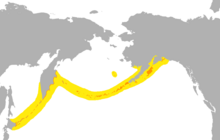| Red-faced cormorant | |
|---|---|

| |
| Conservation status | |
 Least Concern (IUCN 3.1) | |
| Scientific classification | |
| Domain: | Eukaryota |
| Kingdom: | Animalia |
| Phylum: | Chordata |
| Class: | Aves |
| Order: | Suliformes |
| Family: | Phalacrocoracidae |
| Genus: | Urile |
| Species: | U. urile |
| Binomial name | |
| Urile urile (Gmelin, JF, 1789) | |

| |
| Approximate range | |
| Synonyms | |
|
Phalacrocorax urile | |
The red-faced cormorant (Urile urile), red-faced shag or violet shag, is a bird species of the family Phalacrocoracidae.
Its range spans from the eastern tip of Hokkaidō in Japan, northern korean peninsula, via the Kuril Islands, the southern tip of the Kamchatka Peninsula and the Aleutian Arc to the Alaska Peninsula and Gulf of Alaska.
Taxonomy
The red-faced cormorant was formally described in 1789 by the German naturalist Johann Friedrich Gmelin in his revised and expanded edition of Carl Linnaeus's Systema Naturae. He placed it in the genus Pelecanus and coined the binomial name Pelecanus urile. Gmelin based his description on the "red faced shag" of John Latham and the "red faced corvarant" of Thomas Pennant. The authors cited different translations of an account of Georg Wilhelm Steller's exploration of the Kamchatka Peninsula. The red-faced cormorant was formerly classified in the genus Phalacrocorax; it was moved to the resurrected genus Urile based on a molecular phylogenetic study published in 2014. The genus had been introduced in 1856 by the French naturalist Charles Lucien Bonaparte. The epithet urile is possibly derived from the Russian vernacular name of this species, referring to the Kuril Islands where this species is now very rare. The species is monotypic: no subspecies are recognised. Within the genus Urile the red-faced cormorant is closely related to the pelagic cormorant (Urile pelagicus).
Description
The adult bird has glossy plumage that is a deep greenish blue in color, becoming purplish or bronze on the back and sides. In breeding condition it has a double crest, and white plumes on the flanks, neck and rump, and the bare facial skin of the lores and around the eyes is a bright orange or red, giving the bird its name; although the coloration is less vivid outside the breeding season, the red facial skin is enough to distinguish it from the otherwise rather similar pelagic cormorant. Its legs and feet are brownish black. Its wings range from 25 to 29 cm (9.8 to 11.4 in) in extent, with females having on average about 5 cm (2.0 in) shorter wings. Adults weigh between 1.5 and 2.3 kg (3.3 and 5.1 lb), with females averaging 350 g (12 oz) less than males.
Behaviour
Breeding
Where it nests alongside the pelagic cormorant, the red-faced cormorant generally breeds the more successfully of the two species, and it is currently increasing in numbers, at least in the easterly parts of its range. It is however listed as being of conservation concern, partly because relatively little is so far known about it.
Food and feeding
Analysis of stomach contents suggests that the red-faced cormorant is mainly a bottom feeder, taking cottids especially. Adults have few predators, though river otters may attempt to take them, as will corvids of various species, bald eagles and golden eagles. Gulls and corvids are common predators on eggs and chicks.
References
- BirdLife International (2018). "Urile urile". IUCN Red List of Threatened Species. 2018: e.T22696887A133509553. doi:10.2305/IUCN.UK.2018-2.RLTS.T22696887A133509553.en. Retrieved 11 November 2021.
- Gmelin, Johann Friedrich (1789). Systema naturae per regna tria naturae : secundum classes, ordines, genera, species, cum characteribus, differentiis, synonymis, locis (in Latin). Vol. 1, Part 1 (13th ed.). Lipsiae : Georg. Emanuel. Beer. p. 575.
- Latham, John (1785). A General Synopsis of Birds. Vol. 3, Part 2. London: Printed for Leigh and Sotheby. pp. 601–602.
- Pennant, Thomas (1785). Arctic Zoology. Vol. 2. London: Printed by Henry Hughs. p. 584.
- Krasheninnikov, Stepan Petrovich (1764). The History of Kamtschatka, and the Kurilski Islands, with the Countries adjacent. Grieves, James, translator. London: Printed by R. Raikes. p. 157.
- Krasheninnikov, Stepan Petrovich (1768). Voyage En Sibérie, Fait Par Ordre Du Roi En 1761: Contenant La Description du Kamtchatka. Vol. 2. Paris: Chez Debure. p. 493.
- ^ Kennedy, M.; Spencer, H.G. (2014). "Classification of the cormorants of the world". Molecular Phylogenetics and Evolution. 79: 249–257. doi:10.1016/j.ympev.2014.06.020. PMID 24994028.
- ^ Gill, Frank; Donsker, David; Rasmussen, Pamela, eds. (August 2022). "Storks, frigatebirds, boobies, darters, cormorants". IOC World Bird List Version 12.2. International Ornithologists' Union. Retrieved 21 November 2022.
- Bonaparte, Charles Lucien (1856). "Excusion dans les divers Musées d'Allemagne, de Hollande et de Belgique, et tableaux paralléliques de l'ordre des échassiers (suite)". Comptes Rendus Hebdomadaires des Séances de l'Académie des Sciences (in French). 43: 571–579 .
- Jobling, James A. "urile". The Key to Scientific Names. Cornell Lab of Ornithology. Retrieved 21 November 2022.
- Johnsgard, Paul A. (1993). Cormorants, Darters, and Pelicans of the World. Washington: Smithsonian Institution Press. p. 406. ISBN 1-56098-216-0.
- "RED-FACED CORMORANT Phalacrocorax urile" (PDF). U.S Fish & Wildlife Service.
| Order: Suliformes (Phalacrocoraciformes) | |||||||||||||||||||||||
|---|---|---|---|---|---|---|---|---|---|---|---|---|---|---|---|---|---|---|---|---|---|---|---|
| |||||||||||||||||||||||
| |||||||||||||||||||||||
| |||||||||||||||||||||||
| |||||||||||||||||||||||
| Taxon identifiers | |
|---|---|
| Phalacrocorax urile |
|
| Pelecanus urile | |